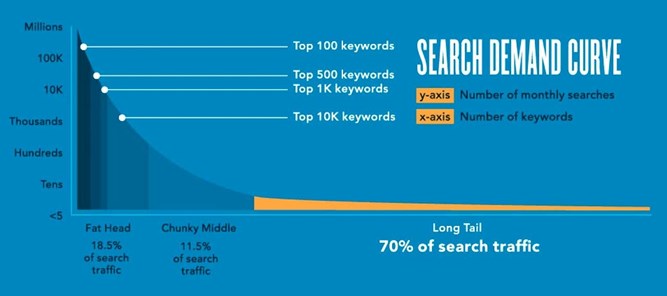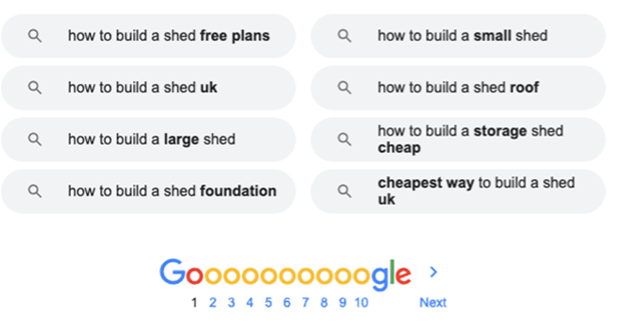Long-Tail Keywords | Less Competition, More Conversions?
02 February 2023
When it comes to the wonderful world of Digital Performance Marketing, keyword optimisation comes out trumps. Without a knowledge of what keywords or search terms your audience are using to find your products or similar, how are you supposed to optimise content, budget and all other activity to maximise conversions?
Well, while keywords are key – our expert advice is to also consider long-tail keywords. Why?
Long-tail keywords get less search traffic, but will usually have a higher conversion value, as they are more specific. They allow you to gradually get more traffic to your site and be found by new and motivated audiences. And who wouldn’t want that?!

Often 1-2 words, these can bring in a wide range of search results – sometimes this can equate to higher cost per clicks and larger search competition. For example, ‘garden furniture’ or ‘garden table’.
Often 3 or more words, Long-tail keywords are keyword phrases that are very specific as they focus on a niche. For example, ‘where to buy garden furniture’ or ‘the best garden tables’.
Ultimately, long-tail keywords are not searched as often because they are so specific, but that provides more targeted results and very high-intent audience click-throughs.
As mentioned above, Long-tail keywords are highly specific search queries. People sometimes assume that the label refers to any search query made up of multiple words, but word from the wise, it refers to niche keywords with low monthly search volumes (approximately one hundred searches a month or less).
More specifically, the ‘long-tail’ refers to the distribution of low-volume keywords inside the search volume curve. The curve’s short tail (aka the ‘head’) contains a small number of high-volume keywords, while the long tail consists of countless low-volume keywords.
Since long-tail keywords have a low search volume, they are easier to rank for.
A generic keyword is more valuable to more websites than a long-tail keyword. For this reason, the search space for long-tail keywords tends to be far less competitive. Long-tail keywords therefore have greater conversion potential because a user has a clear idea of the type of result they want. In other words, they are past the ‘awareness’ stage and closer to the ‘consideration’ or ‘purchase-ready’ stage of the buyer’s journey.
For example, let’s say you’re a potential buyer considering what vitamins are the best to buy online. You could be searching generally for ‘vitamins for women’ or ‘best vitamins’ (short-tail and generic, but you would get a huge amount of search results – some useful, some not so much. Where as, if you’re further down your buying journey, you’re ready to make a purchase, you might search using the phrase ‘best vitamins to buy’ or ‘best vitamins to take for energy levels’ (long-tail, specific, but to drive conversions from high-intent audiences).
Since long-tail keywords tend to correspond to specific user queries, it is far easier to work out the keyword’s search intent. Think of search intent as the specific problem a user tries to solve when conducting a search.
For example, if someone searches ‘how to poach an egg in a microwave,’ there is no confusion about the type of result they expect to find. Conversely, if someone searches for the more generic term ‘egg recipe,’ it may be harder to decipher what they are looking for.
For this reason, generic keywords often lead to a mixed bag of search results, with different results catering to different search intents. So even if you succeed in ranking for them, you may not receive the astronomical traffic you expect. With long-tail keywords however, the search intent is clear. You should have no difficulty creating a piece of content that matches exactly what the user is looking for.
Since there is an unlimited supply of long-tail keywords to target within any given niche, you are unlikely to run out of new, relevant content ideas. And while each new piece of content may not attract huge levels of traffic individually, the cumulative effect of publishing multiple posts allows you to increase your visitor count steadily over time.
This is the logic behind so-called ‘content clusters.’ The idea is to create one piece of pillar content targeting your primary keyword (for example, ‘how to build a shed’) and a range of smaller ‘cluster’ pieces targeting related, long-tail keywords (for example, ‘building a shed roof’). Your pillar piece should link to your cluster pieces, and your cluster pieces should link to each other wherever it makes sense.
The key to rolling this out is collecting a Long-Tail Keyword List:
You’ll need to build out a list of potential keywords by using your topic ideas as test terms. There are several ways to approach this, but we would suggest using Google search itself. Google is the juggernaut after all!
Once you start typing your test terms into the Google search bar, multiple keyword suggestions will appear in a drop-down menu. These suggestions represent real-life queries that Google users have searched around the topic in question.
Also, at the bottom of the results page for your seed term, you will find a list of related search queries:

Do this free test for all your potential terms and add as many relevant keywords to your list as possible.
It’s important to note on this too, always consider your audience when it comes to short-tail versus long-tail keywords. For example, if your brand is looking to expand reach and drive online sales in the US / Canada, where search volumes are HUGE – long-tail will serve you well, as it’s a less competitive space. But it’s essential to consider short versus long on a case by case, sector by sector, business by business basis. It won’t work for everyone, but it could be spot on for your brand.
There you have it – a quick start guide to Long-tail keywords. And this feels like a good time to add, this can influence both PPC Advertising and SEO work – both of which our team are experts in. So, if you have any questions or want to discuss your keywords, get in touch!